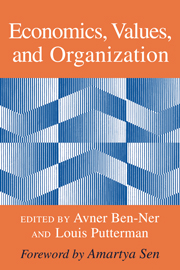Book contents
- Frontmatter
- Contents
- Foreword
- Preface
- List of contributors
- Introduction
- 1 Values and institutions in economic analysis
- Part I The formation and evolution of social norms and values
- Part II The generation and transmission of values in families and communities
- Part III Social norms and culture
- Part IV The organization of work, trust, and incentives
- Part V Markets, values, and welfare
- Epilogue
- Index
1 - Values and institutions in economic analysis
Published online by Cambridge University Press: 05 June 2012
- Frontmatter
- Contents
- Foreword
- Preface
- List of contributors
- Introduction
- 1 Values and institutions in economic analysis
- Part I The formation and evolution of social norms and values
- Part II The generation and transmission of values in families and communities
- Part III Social norms and culture
- Part IV The organization of work, trust, and incentives
- Part V Markets, values, and welfare
- Epilogue
- Index
Summary
Introduction
The subject of values was once considered to lie beyond the purview of economic science. Preferences, taken as given to the agent and society, were seen as being about goods, dates of consumption, and states of the world, not about means (how to behave), or about beneficiaries other than the self. But as industrial civilization ends a turbulent century with rising anxiety over its social health and cohesion, the subject of values has begun seeping into economic discourse.
That neoclassical economics viewed values as an alien issue may have been natural given the positivistic spirit of its proponents. Robbins (1932) defined economics as a science of means–ends relationships, with the choice of ends (preferences) being of no account. And when Adam Smith's “Invisible Hand” revealed itself in the theory of general equilibrium, its manifestation was that of a vector of prices supporting an optimal allocation of resources, with preferences, technologies, endowments, and even the structure of property rights and institutions taken as givens. “De gustibus non disputandum est” and, a fortiori, “de moribus,” since economics was becoming a science of prediction and testing, whereas value statements are inherently not amenable to falsification. Assuming behavior based on self-interest, exploring where that led using deductive reasoning and mathematics, and testing the resulting conclusions using data on observable choices: These became the methodological Tao of the economics profession.
But as research in the neoclassical tradition expanded, it became clear that the economics of the mid-twentieth century had not really been as self-consistent as had been hoped.
- Type
- Chapter
- Information
- Economics, Values, and Organization , pp. 3 - 70Publisher: Cambridge University PressPrint publication year: 1998
- 51
- Cited by



